WYOMING
August 29 — September 11, 2001
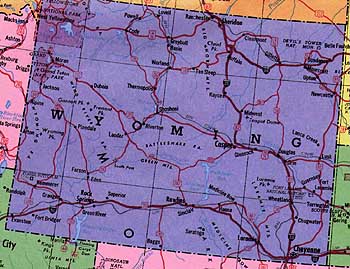 Most folks who have
visited Wyoming
would agree that it is a state of great contrasts. If you have simply hurried
from Chicago to San Francisco across the southern part of the state along
Interstate 80, it is difficult to see the great beauty and variety that
lies in wait for those who venture on the two-lane highways and gravel
roads. Though it’s true that most of the people in Wyoming live along I-80,
in Rock Springs, Rawlins, Laramie, and Cheyenne, the really interesting
parts of the state are places like Pinedale, Atlantic City, Lander, Jackson,
Thermopolis, the hundreds of miles of national forest roads, and the two
premier national parks in the state: Yellowstone and Grand Teton. The names
of towns and counties conjure up people and events that are closely associated
with the western myths of 19th century America: Bridger and Sublette, Cody
and Buffalo, Jackson and Moran.
Most folks who have
visited Wyoming
would agree that it is a state of great contrasts. If you have simply hurried
from Chicago to San Francisco across the southern part of the state along
Interstate 80, it is difficult to see the great beauty and variety that
lies in wait for those who venture on the two-lane highways and gravel
roads. Though it’s true that most of the people in Wyoming live along I-80,
in Rock Springs, Rawlins, Laramie, and Cheyenne, the really interesting
parts of the state are places like Pinedale, Atlantic City, Lander, Jackson,
Thermopolis, the hundreds of miles of national forest roads, and the two
premier national parks in the state: Yellowstone and Grand Teton. The names
of towns and counties conjure up people and events that are closely associated
with the western myths of 19th century America: Bridger and Sublette, Cody
and Buffalo, Jackson and Moran.
Three years ago we worked our way
through parts of the state: Jackson
and the Tetons, Lander and the Wind
River Indian Reservation, the hot springs at Thermopolis (largest in the world),
and the ghosts of fabulous mines at Atlantic
City and South Pass. This year, we combined our annual reunion with Judy’s high
school girl friends and their spouses with camping in areas of the state we’d not visited
before. The result was two weeks of relaxing in some of our country’s most stunning scenery,
best hiking, and cleanest air. We learned some things along the way and left with some quirky
impressions:
Fact: Wyoming, like many western states,
derives its name from a language other than English: Algonquin or Delaware for “large prairie
place.”
Fact: There are more residents of Denver than
in Wyoming. Fewer than a half million people (our smallest state in population, though 10th in size)
and we think that’s probably half again too many for most folks who live there.
Fact: Yellowstone
National Park was the first national park in the world (1872), straddles three states, has a majority of
the world’s geysers (250) and hot springs (10,000), and is larger than Rhode Island and Delaware combined.
Fact: Devil’s
Tower was the first National Monument (1906) and was recreated in mashed potatoes by a frenzied
Richard Dreyfus in “Close Encounters of the Third Kind.”
Fact: Wyoming was home to the first J(ames) C(ash)
Penney store (in Kemmerer),  the
first dude ranch (Eaton Ranch near Wolf), and the largest US coal mine (near Wright). The first woman in
the USA legally voted there in 1869.
the
first dude ranch (Eaton Ranch near Wolf), and the largest US coal mine (near Wright). The first woman in
the USA legally voted there in 1869.
Fact: Wyoming license plates show a image of a guy
riding a bucking bronco. That horse is “Old Steamboat,” a horse that was never ridden.
Impression: If folks from Wyoming can’t drive there
or ride there, they don’t go there. As one fellow said, “Around here, paving a trail is a sign of
progress.”
We found few footprints—in some cases no footprints—on hiking trails in Wyoming. There were,
however, signs of horses, deer, moose, motorcycles, ATVs, and pick-ups.
Impression: There probably are more pick-up trucks
in Wyoming than cars or people—maybe more than both combined!
Impression: Yellowstone bears that used to beg food
from tourist cars have been either run out of the park, gone into deep hiding, or relocated to some other
tourist facility. Those pictures you remember from the 1950s post cards are a piece of fading Americana along
with Route 66 and White Castles. The same may be true for moose; we didn’t see a one.
GETTING THERE
We planned to meet the other two couples at the Old Faithful
Inn on September 4. We had nearly a week to get there bys lowly working our way up the middle of the state.
We drove through Fort Collins, turned west along
the Cache le Poudre River (that’s just the
plain old Pooh-der River out here) to the flats of North Park and Walden (it can’t have a thing to do
with Thoreau’s pond!!) and north to the east side of the Snowy Range just across the line in Wyoming and the beginnings of the
North Platte River.
just across the line in Wyoming and the beginnings of the
North Platte River.
We camped the first night near the town
of Encampment just north of the Colorado
line, 50 or so miles west of Laramie. Encampment’s name goes back to the meeting site of fur traders of the
early 19th century, but its true growth relied upon a short lived copper and gold mining boom in the late
1890s when it was predicted by some that the area would grow beyond the population and importance of Denver!
All that remains now are two of the “fabulous” towns (Riverside is the other) and a museum that not only recounts the area’s past but also
features a fold up bathtub and a two-story outhouse!
Camping in the national forest just south of town was
excellent, the fishing probably better than we found it, and hiking along the Encampment Trail from
the campground was quite nice. On the opposite side of the river from the trail is a surprisingly
extensive area of private homes behind a locked gate identified as the property of the IOOF, Independent Order of Odd Fellows). There were some Odd
Fellows going in and out from their homes, but we had the entire campground to ourselves, the dogs
ran freely, and the night was quiet. The next day we drove to Rawlins,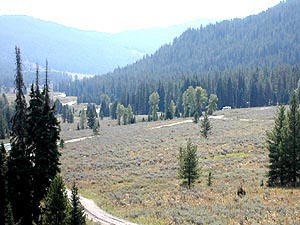 crossed I-80, and headed north to Pinedale where we shopped for groceries and spent a night at
Elkhart Park C.G. above Fremont Lake. We hiked briefly there but it was late in the day and Judy
wanted to do a run before dinner.
crossed I-80, and headed north to Pinedale where we shopped for groceries and spent a night at
Elkhart Park C.G. above Fremont Lake. We hiked briefly there but it was late in the day and Judy
wanted to do a run before dinner.
We left the next morning and looked for a campground for
the Labor Day weekend. It was our good fortune to choose Granite Creek C.G. ten miles of gravel north
of US 189/191. It is one of the most beautiful camping areas we’ve seen: +50 sites located just below
Granite Falls and a short mile below Granite
Hot Springs! We hiked, fished, rode our bikes, and relaxed in the hot springs while the weather was
sensational. If we hadn’t planned to be in Jackson, we’d have stayed much longer.
Since we were going to be in two national parks, we
planned in advance for Sophie and Bella to have a new experience: four nights at the Spring Creek Kennels
in Jackson. We dropped them off in the morning, along with their food, familiar toys, their cuddle bed,
and plenty of instructions. We left them, hoping they would be in good hands, and drove on up to Yellowstone.
YELLOWSTONE NATIONAL PARK
 Yellowstone’s
Old Faithful Inn is one of the grand
national park hotels created just after the turn of the last century for the wealthy park visitors who
required creature comforts along with their wilderness experience. It was the first of a handful of remarkable hotels built in the
“Rustic Style” at other western parks, including the lodges at Crater Lake, Timberline Lodge, three in
Glacier, Waterton Lakes, El Tovar at Grand Canyon’s South Rim and a half dozen others. Christine
Barnes’
Great Lodges of the West beautiful photo-history pays homage to these
amazing buildings that all began with the Old Faithful Inn. Staying there was an experience in itself,
and compared to the outrageous prices charged at Grand Teton, Yellowstone remains an affordable as well
as remarkable place to visit. We bicycled through the Upper Geyser Basin area before returning to the Inn
to meet the other two couples. We sat on the second story deck outside to watch Old Faithful “go
off” that
afternoon and caught up on the past year and planned our few days together.
Yellowstone’s
Old Faithful Inn is one of the grand
national park hotels created just after the turn of the last century for the wealthy park visitors who
required creature comforts along with their wilderness experience. It was the first of a handful of remarkable hotels built in the
“Rustic Style” at other western parks, including the lodges at Crater Lake, Timberline Lodge, three in
Glacier, Waterton Lakes, El Tovar at Grand Canyon’s South Rim and a half dozen others. Christine
Barnes’
Great Lodges of the West beautiful photo-history pays homage to these
amazing buildings that all began with the Old Faithful Inn. Staying there was an experience in itself,
and compared to the outrageous prices charged at Grand Teton, Yellowstone remains an affordable as well
as remarkable place to visit. We bicycled through the Upper Geyser Basin area before returning to the Inn
to meet the other two couples. We sat on the second story deck outside to watch Old Faithful “go
off” that
afternoon and caught up on the past year and planned our few days together.
We could choose to see the highlights or visit one area in
depth. We opted for the highlights, an all day driving/walking tour of the areas around the Grand Canyon
of the Yellowstone and Mammoth Hot Springs (where we got the largest single dip ice cream cone any of us
had ever seen). Some of us who had toured the park in the past noted that some of the Mammoth Hot Springs
had certainly changed in the 20-30 years since last visited.
In the morning we took a guided tour of the Inn conducted
by a park docent who shared the history of the building in a most interesting way. Afterward, we walked
from the Inn through the Upper Geyser Basin to the Morning Glory Pool. The weather was cool and overcast
which made the steam from the geysers and hot springs even more spectacular. On the way out, Hughes jumped
into fly fishing feet first by buying a fly rod and reel at one of the Hamilton’s stores in the park (and
later he would buy his vest at a sporting goods store in Jackson). He may not have caught a single fish on
the trip, but he looked good trying.
GRAND TETON NATIONAL PARK
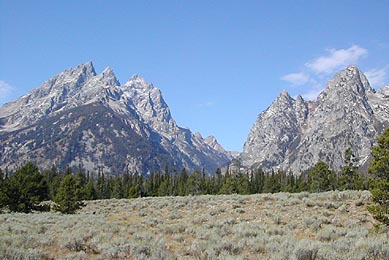
There is some controversy over the meaning of the word
“teton.” The usual explanation refers to a French word meaning “big breast.” The storyteller often
describes an imaginative French trapper who, having been without polite (or even impolite) society for
a long time, viewed the rugged spires of mountains pushing nearly straight up from the banks of the
Snake River and saw something female that he’d been missing for many months or years. Of course,
that’s
makes a good story for the tourists from back east (and some of their western countrymen as well).
On the other hand, we have an etymologist John E. Koontz’ assertion that “the name of the Teton branch of the Dakota is from the Dakotan word thi’thuNwaN
(TEE-too-wah, the last two vowels being nasal). This looks like a compound of thi’ ‘to
dwell’, as
in thi’pi ‘dwelling’, and thuNwaN meaning roughly ‘village, villagers, dwellers
at’. The latter
root does not occur as an independent word. However, it is believed that the first root is actually
an irregular modification of thiNl (pronounced thiNn), the compounding form of thiN’ta
‘prairie’.
Hence it would be ‘Prairie Dwellers, Prairie Village People’.”
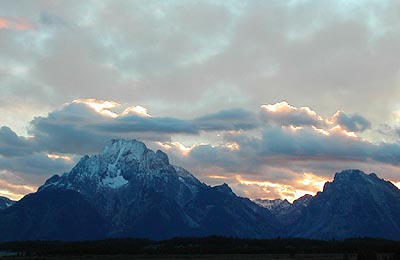 Most folks probably enjoy the usual explanation, suspecting Mr. Koontz’ explanation may be a bit too
politically correct. You pays yer money, you takes yer choice.
Most folks probably enjoy the usual explanation, suspecting Mr. Koontz’ explanation may be a bit too
politically correct. You pays yer money, you takes yer choice.
The park was formed initially in 1929 which included only
the Teton Range and eight glacial lakes at the base of the mountains. Jackson Hole National Monument,
created by Franklin Delano Roosevelt in 1943, combined Teton National Forest acreage, other federal
properties including Jackson Lake, and a 35,000-acre donation by John D. Rockefeller, Jr. The Rockefeller
lands continued to be privately held until December 16, 1949, when an impasse for addition to the National
Park was resolved. In 1950, the original 1929 Park, the 1943 National Monument, and Rockefeller’s donation
were united into a “New” Grand Teton National Park, creating present-day boundaries.
There is little debate over the spectacle of the mountains
rising so abruptly and majestically from the valley floor. The 12,000'–13,000' are dazzling, especially
when viewed from one of the serene lakes at the foot of the mountains: Jenny, Jackson, Leigh, and String Lake
that connects Jenny and Leigh. Our destination was Colter Bay, at the north end of the park on Jackson Lake,
where we had reserved three cabins.
With just a short period of time to enjoy the park, we decided
that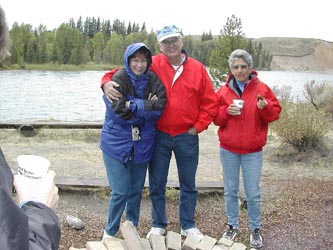 we would (1) take
a float trip down the Snake River and (2) either go horseback riding in the park or fish. In the end we did
not go horseback riding. The weather turned cool and damp that morning (here in Nederland, it snowed
8") and
our float trip was a chilling experience! We saw ospreys and eagles, but the larger animals must have been
holed up keeping warm as we passed by on our ten mile voyage. When we pulled out of the river, we found not
only a hearty lunch waiting for us, but a warming fire and plenty of hot chocolate and coffee. Did we complain?
Not a bit.
we would (1) take
a float trip down the Snake River and (2) either go horseback riding in the park or fish. In the end we did
not go horseback riding. The weather turned cool and damp that morning (here in Nederland, it snowed
8") and
our float trip was a chilling experience! We saw ospreys and eagles, but the larger animals must have been
holed up keeping warm as we passed by on our ten mile voyage. When we pulled out of the river, we found not
only a hearty lunch waiting for us, but a warming fire and plenty of hot chocolate and coffee. Did we complain?
Not a bit.
That afternoon, the horseback riders decided to warm up
quietly in their rooms, resting perhaps. Armed with a new rod and reel and a few choice flies, Hughes
set off in search of the elusive Snake River trout. He had a great hike in the cold rain and snow. He
returned empty handed but glad he didn’t have to clean and cook fish that evening. Dinner that evening
was at the Jackson Lake Lodge with a spectacular view of the Tetons from every table.
The next morning was set aside for some cautious retail
therapy in Jackson and one of the finer milkshakes in the country at the historic Jackson Drug Co.
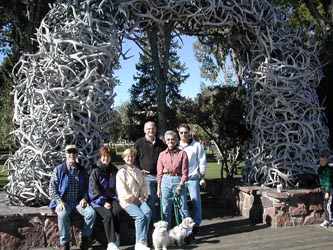 We picked up Bella and Sophie who rejoiced at our reunion and walked around the town until it was
time for each of us to go our separate ways: Tom and Pat to Salt Lake City, Lee and Irene to Idaho,
and the Moirs to spend the night near the small town of Kelly (location for the 1950s classic
“Shane”)
where we camped on Lower Slide Lake, formed by the mile wide Gros Ventre (rhymes with “low
haunt”)
Slide that occurred in 1925. We hiked briefly above the lake, scaring up a couple of deer and letting
the dogs run freely for the first time in several days. If there were fish in the lake, they were all
out in the middle far from shore.
We picked up Bella and Sophie who rejoiced at our reunion and walked around the town until it was
time for each of us to go our separate ways: Tom and Pat to Salt Lake City, Lee and Irene to Idaho,
and the Moirs to spend the night near the small town of Kelly (location for the 1950s classic
“Shane”)
where we camped on Lower Slide Lake, formed by the mile wide Gros Ventre (rhymes with “low
haunt”)
Slide that occurred in 1925. We hiked briefly above the lake, scaring up a couple of deer and letting
the dogs run freely for the first time in several days. If there were fish in the lake, they were all
out in the middle far from shore.
RETURN TRIP HOME
The road between Grand Teton and the center of the
state (generally from Moran Junction in the park to Lander just on the edge of the Wind River Indian
Reservation) has been appropriately designed a scenic highway by the state of Wyoming. It follows the
Wind River through Bridger-Teton and Shoshone National Forests to Dubois, an area hunting, fishing, camping, snowmobile
center. We drove through Sinks Canyon State Park and camped along the Middle Popo Agie (po-po ah-she-ah)
River. We hiked for about three miles to the first falls/cascades that even in this relatively dry Wyoming
summer sparkled and spewed spray. The weather was perfect—warm and dry—and we almost stayed another
day or two, except that our time was drawing short and we wanted to explore the Snowy Range near Laramie.
We returned to Saratoga (certainly named after the city in
New York that also has a hot springs) whose slogan boasts “Where the Trout Leap in Main Street” and turned
east on the Snowy Range Scenic
Byway that leads into one of Wyoming’s least known gorgeous areas. We stopped at Lake Marie, a high
alpine lake along the highway to feel the afternoon chill on a sunny day at 9000'. We camped that evening
at North Fork (of the Little Laramie River) C.G. which was virtually deserted, except for several expectant
mocking birds looking for a handout; three of the 61 sites were taken,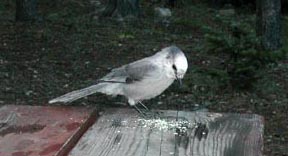 all in the north side of the park. We settled on the
south side near the river. Judy went for a run and Hughes looked for pools big enough for fish and wide
enough not to snag his flies. Judy was successful, Hughes was not.
all in the north side of the park. We settled on the
south side near the river. Judy went for a run and Hughes looked for pools big enough for fish and wide
enough not to snag his flies. Judy was successful, Hughes was not.
That night we listened to the Broncos home opener until half-time when we couldn’t stay awake
any longer (somewhere between 8:30 and 9:00, which was typical for this trip). In the morning, we turned
on the radio to find out who won the game, but heard the beginning reports of the World Trade Center
catastrophes and all that followed. Suddenly our need to be home was greater than the serenity of the
mountains. We made a beeline for home.
FINAL THOUGHTS ON WYOMING
It’s a big state with lots of space between places that
interest us. There is a great deal of beauty along with the monotony that travelers experience as they
cross I-80, and you have to get off the interstates to find it. But your efforts will be rewarded.
We’ll
go back—to the camping areas and parks we’ve been to before, as well as to places that remain dots
on a map. We’ll always find good hiking and someplace we’ll find good fishing.
 Most folks who have
visited Wyoming
would agree that it is a state of great contrasts. If you have simply hurried
from Chicago to San Francisco across the southern part of the state along
Interstate 80, it is difficult to see the great beauty and variety that
lies in wait for those who venture on the two-lane highways and gravel
roads. Though it’s true that most of the people in Wyoming live along I-80,
in Rock Springs, Rawlins, Laramie, and Cheyenne, the really interesting
parts of the state are places like Pinedale, Atlantic City, Lander, Jackson,
Thermopolis, the hundreds of miles of national forest roads, and the two
premier national parks in the state: Yellowstone and Grand Teton. The names
of towns and counties conjure up people and events that are closely associated
with the western myths of 19th century America: Bridger and Sublette, Cody
and Buffalo, Jackson and Moran.
Most folks who have
visited Wyoming
would agree that it is a state of great contrasts. If you have simply hurried
from Chicago to San Francisco across the southern part of the state along
Interstate 80, it is difficult to see the great beauty and variety that
lies in wait for those who venture on the two-lane highways and gravel
roads. Though it’s true that most of the people in Wyoming live along I-80,
in Rock Springs, Rawlins, Laramie, and Cheyenne, the really interesting
parts of the state are places like Pinedale, Atlantic City, Lander, Jackson,
Thermopolis, the hundreds of miles of national forest roads, and the two
premier national parks in the state: Yellowstone and Grand Teton. The names
of towns and counties conjure up people and events that are closely associated
with the western myths of 19th century America: Bridger and Sublette, Cody
and Buffalo, Jackson and Moran.
 the
first dude ranch (Eaton Ranch near Wolf), and the largest US coal mine (near Wright). The first woman in
the USA legally voted there in 1869.
the
first dude ranch (Eaton Ranch near Wolf), and the largest US coal mine (near Wright). The first woman in
the USA legally voted there in 1869.
 just across the line in Wyoming and the beginnings of the
North Platte River.
just across the line in Wyoming and the beginnings of the
North Platte River.
 crossed I-80, and headed north to
crossed I-80, and headed north to  Yellowstone’s
Yellowstone’s

 Most folks probably enjoy the usual explanation, suspecting Mr. Koontz’ explanation may be a bit too
politically correct. You pays yer money, you takes yer choice.
Most folks probably enjoy the usual explanation, suspecting Mr. Koontz’ explanation may be a bit too
politically correct. You pays yer money, you takes yer choice.
 we would (1) take
a float trip down the Snake River and (2) either go horseback riding in the park or fish. In the end we did
not go horseback riding. The weather turned cool and damp that morning (here in Nederland, it snowed
8") and
our float trip was a chilling experience! We saw ospreys and eagles, but the larger animals must have been
holed up keeping warm as we passed by on our ten mile voyage. When we pulled out of the river, we found not
only a hearty lunch waiting for us, but a warming fire and plenty of hot chocolate and coffee. Did we complain?
Not a bit.
we would (1) take
a float trip down the Snake River and (2) either go horseback riding in the park or fish. In the end we did
not go horseback riding. The weather turned cool and damp that morning (here in Nederland, it snowed
8") and
our float trip was a chilling experience! We saw ospreys and eagles, but the larger animals must have been
holed up keeping warm as we passed by on our ten mile voyage. When we pulled out of the river, we found not
only a hearty lunch waiting for us, but a warming fire and plenty of hot chocolate and coffee. Did we complain?
Not a bit.
 We picked up Bella and Sophie who rejoiced at our reunion and walked around the town until it was
time for each of us to go our separate ways: Tom and Pat to Salt Lake City, Lee and Irene to Idaho,
and the Moirs to spend the night near the small town of Kelly (location for the 1950s classic
“Shane”)
where we camped on Lower Slide Lake, formed by the mile wide Gros Ventre (rhymes with “low
haunt”)
Slide that occurred in 1925. We hiked briefly above the lake, scaring up a couple of deer and letting
the dogs run freely for the first time in several days. If there were fish in the lake, they were all
out in the middle far from shore.
We picked up Bella and Sophie who rejoiced at our reunion and walked around the town until it was
time for each of us to go our separate ways: Tom and Pat to Salt Lake City, Lee and Irene to Idaho,
and the Moirs to spend the night near the small town of Kelly (location for the 1950s classic
“Shane”)
where we camped on Lower Slide Lake, formed by the mile wide Gros Ventre (rhymes with “low
haunt”)
Slide that occurred in 1925. We hiked briefly above the lake, scaring up a couple of deer and letting
the dogs run freely for the first time in several days. If there were fish in the lake, they were all
out in the middle far from shore.
 all in the north side of the park. We settled on the
south side near the river. Judy went for a run and Hughes looked for pools big enough for fish and wide
enough not to snag his flies. Judy was successful, Hughes was not.
all in the north side of the park. We settled on the
south side near the river. Judy went for a run and Hughes looked for pools big enough for fish and wide
enough not to snag his flies. Judy was successful, Hughes was not.
